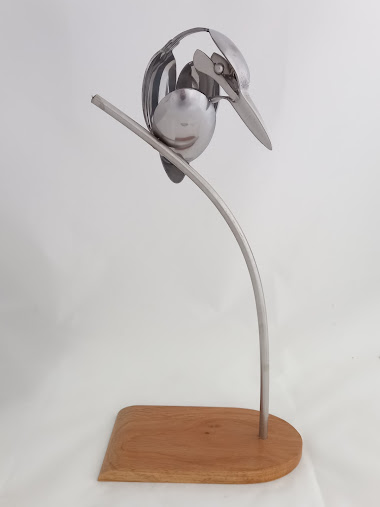PLEASE EMAIL ME YOUR REQUEST AND I WILL GET BACK TO YOU AS SOON AS POSSIBLE
I take pride in packaging my orders up really nicely with 'eco' materials!
£10 for postage and packaging for UK mainland per item. Possibly multiple items if in one box depending on size and weight.
If you’re looking for a unique and special gift then take a closer look at Ed Hill’s Metal Art. You will discover several designs that are the product of much work and creative thought. They have been inspired and handmade in the heart of the beautiful South Hams. The ideas are developed by studying photos, cardboard modelling, clay sculpting and metal prototyping. They have striking realism that will make a statement in any home or garden. On closer inspection you will see they are made from recycled cutlery and metal. Look for the special or hidden details of this in each piece. The repurposed metal shines with a spirit of renewal and honours that which it reflects. The sculptures catch and play with the light throughout the day and bring life to a dark or otherwise uninteresting part of the garden. |
*Premium Cutlery: Regarding your decision both are suitable for outdoors. Stainless steel corrodes much slower than mild steel. Mild steel goes completely brown within a couple of weeks unless protected by something. I take time to remove cutlery that I think is very cheap and will corrode fast. This usually looks thin, bends easily, brittle, has a grainy texture, appears stamped and markings are few or very basic. It may already show signs of corrosion, such as pitting, or rust spots.
The 'standard cutlery' on the other hand is harder to bend, has smoother edges, clear makers stamps some well-known. Smoother finish and less grainy.
Even stainless steel is on a journey of corrosion, it's just some corrode faster than others, it's just a matter of time, but we can do things to help slow it down.
The 'premium cutlery' offers better corrosive resistance, this means it may require less maintenance to protect or clean it in the long run. This is because it exhibits characteristics such as: 'non-magnetic' and or marked with it's nickel content e.g. 18/8 or 18/10. It is usually slightly wieghtier, smoother, chunkier and has a subtle golden lustre to it, which is the nickel. It does not tend to be heavily patterned either.
Because, the quality of cutlery varies so much, I can’t guarantee it won’t discolour over time. If you would like your sculpture to remain shiny and stainless you may need to clean, oil or lacquer it. This particulary true of marine environments where the salty air can be very corrosive to metal. You may decide to display it indoors, in which case please see one of the options I have above.
CARE INSTRUCTIONS
·
Use a bathroom cleaner for example ‘Cif’ or equivalent and
sponge
·
Use a polish designed for cleaning and protecting
stainless steel, such as ‘Peek Polish’.
·
Place in the dishwasher if it is small enough and is
entirely cutlery based.
·
Oil it with WD40, Vaseline or equivalent.
·
If you live close to the sea and the air is
particularly corrosive then lacquer your sculpture if oiling is not providing
sufficient protection.
·
Avoid placing your sculpture under hard or acid water
fountains, as this can be corrosive to the cutlery.
·
Avoid wetting your sculpture if it has bike chain as
this will rust – This is only used on sculptures specified as ‘indoor
sculptures’ anyway.
For ‘Iridescent Color Steel’
·
Clean with warm soapy water and non-abrasive material
·
Damp the surface before wiping to soften any debris
·
Carefully remove any grit before wiping the surface so
not to scratch the surface when cleaning
·
Avoid cleaning with abrasive materials or cleaners as
these will permanently scratch the surface.
·
Avoid placing your sculpture under hard or acid water/fountains,
as this permanently damage the surface









